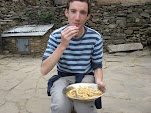A quick Nepali lesson for you, otherwise this is going to become very longwinded.
Didi [dee-de] Older sister
Bhinajyu [bhin-aah-jew] Older sister's husband
Bhanja [bhan-jaa] Nephew
Now wasn't that hard. The tricky bit is knowing that not only your own family members can be called these names, but everyone else as well. Therefore, a lady you know who is old enough to be your sister is Didi, her husband is Bhinajyu, and her son is Bhanja. Which saves remembering names - something I always fail at dramatically - however does cause the slight confusion when you don't quite know which Didi, Bhinajyu or whoever they are talking about.
Anyway.
Whilst we were in Rajghat, we visited Didi's house. She had got married when my friends lived in Rajghat and now lived in a village nearby. When we were there she showed us her lychee tree. Now, for me lychees came in cans and looked rather like peeled grapes. Not that I ever ate them - I just saw them in the Chinese take-away for sale at extortionate prices. I have a very vague recollection of using them in a cake we made to save the rainforest when I was in primary school - those cakes bought us 60 acres of prime Costa Rican rainforest - but that is all. These, however, looked rather prickly. Nothing like the grapes I imagined them to be. They would be ripe in a week she said, but there were some already ripe at the top. And fortunately they had found someone tall enough to pick them. Me. So I grabbed a handful of the most red lychees and handed them out.
Now came problem that I've experienced quite a few times and is rather embarrassing. Having never eaten lychees before, I hadn't the first idea how to eat them. Did you just throw them in your mouth whole, prickly bits and all? Did you dig into the middle and eat the small centre bit? Was there a skin to peel off? Were there seeds in the middle, and what was the likelihood of breaking a tooth on them? Normally, I am able to cunningly overcome this problem by watching everyone else, and how they do it. This caught me out once as I copied a child who was swiftly reprimanded by an outraged parent for playing with his food. This time I could not copy. I was handed four or five and looked at expectantly. And i waited for everyone else to eat. But they didn't, they were waiting for me. So in a hushed and subtle tone I asked kosari? - how? A slight snigger from small Bhanja escaped before Achut put me right. You peel it. However, he didn't tell me about the pip in the middle, and when i bit into that the sweet taste went instantly bitter. After a few, I seemed to master eating it without damaging my teeth, but still couldn't escape the juice rolling down my arm.
For the last week or so, I have been trying to write the proposal for the health post. To be honest, its not been going great for 2 main reasons. Firstly I don't quite know what to put into the proposal. We visited a friend's NGO to see if we could get any information out of them, they were very cagey in helping us. I suppose there is only a limited amount of development funding in Nepal, so why would they help us when they are competing for the same money. So I figured the next step was to try and speak to some friendly funding bodies, and see what they want and how we can get money from them. Hopefully soon someone will reply to me. The other reason is I have turned lazy. Well, it's not lazy as such, but there just doesn't seem to be enough time in the day. I wake at 6.30 or so and watch the news and study Nepali before breakfast at 10. Then I sleep again - tiring work eating you know - and wash before picking up the proposal. But then another cup of tea is brought in and I stop. And then I talk for a bit, forgetting about what I'm supposed to be doing. By the time 3 in the afternoon arrives, so does tiffin - afternoon tea - followed older Bhanja returning from school and then I really have no chance of working. It's sometimes difficult to go outside because when it's sunny it's too hot, and when it's not it's just about to rain. So how to solve this? I think once I get a bit of direction I'll overcome this, but it slightly concerning state of affairs. The problems of being your own boss.
On the more positive side of things, I have been improving a bit in my Nepali now, and am becoming more confident. I am allowed out by myself more often now, however with the heat/rain combination that is sometimes a battle of wills as well. I have been working on a couple of websites for some friend's NGOs here as well, so I'm not completely slack.
Last night the lightning returned to the valley. Bhinajyu was visiting Kathmandu for his work, and brought with him a huge bag full of nicely ripe lychees. So, we sat on the roof on a straw mat watching the lightning, eating lychees.
And yes, my arm was covered in juice.
SAM

